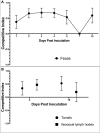Pathogenicity and Competitive Fitness of Salmonella enterica Serovar 4,[5],12:i:- Compared to Salmonella Typhimurium and Salmonella Derby in Swine
- PMID: 32083096
- PMCID: PMC7002397
- DOI: 10.3389/fvets.2019.00502
Pathogenicity and Competitive Fitness of Salmonella enterica Serovar 4,[5],12:i:- Compared to Salmonella Typhimurium and Salmonella Derby in Swine
Abstract
Since 2014, Salmonella 4,[5],12:i:- has emerged as the most common serovar of Salmonella enterica identified from swine samples submitted to veterinary diagnostic laboratories in the United States. To compare the pathogenicity of S. 4,[5],12:i:- in swine to the known pathogenic Salmonella Typhimurium and lesser pathogenic Salmonella Derby, 72 pigs (20 per Salmonella serovar treatment and 12 controls) were inoculated with either S. Typhimurium, S. 4,[5],12:i:-, S. Derby, or sham-inoculated and followed for up to 28 days thereafter via rectal temperature, fecal scoring, and fecal culture. Animals were euthanized on days 2, 4, or 28 to determine the gross and histopathologic signs of disease and tissue colonization. The results clearly demonstrate that for the isolates selected, serovar 4,[5],12:i:- possesses similar ability as serovar Typhimurium to cause clinical disease, colonize the tonsils and ileocecal lymph nodes, and be shed in the feces of infected swine past resolution of clinical disease. To compare the competitive fitness of S. 4,[5],12:i:- to S. Typhimurium in swine when co-infected, 12 pigs were co-inoculated with equal concentrations of both S. Typhimurium and S. 4,[5],12:i and followed for up to 10 days thereafter. When co-inoculated, serovar 4,[5],12:i:- was consistently detected in the feces of a higher percentage of pigs and at higher concentrations than serovar Typhimurium, suggesting an increased competitive fitness of 4,[5],12:i:- relative to serovar Typhimurium when inoculated simultaneously into naïve pigs. Whole genome sequencing analysis of the isolates used in these studies revealed similar virulence factor presence in all S. 4,[5],12:i:- and S. Typhimurium isolates, but not S. Derby, providing additional evidence for similar pathogenicity potential between serovars 4,[5],12:i:- and Typhimurium. Altogether, this data strongly supports the hypothesis that S. 4,[5],12:i:- is a pathogen of swine and suggests a mechanism through increased competitive fitness for the increasing identification of Salmonella 4,[5],12:i:- in swine diagnostic samples over the past several years.
Keywords: 4,[5],12:i:-; Derby; Salmonella; Typhimurium; monophasic; pathogenesis; porcine; swine.
Copyright © 2020 Naberhaus, Krull, Arruda, Arruda, Sahin, Schwartz, Burrough, Magstadt, Matias Ferreyra, Gatto, Meiroz de Souza Almeida, Wang and Kreuder.
Figures











References
-
- Fedorka-Cray PJ, Gray JT, Wray C. Salmonella infections in pigs. In: Wray C, Wray A, editors. Salmonella in Domestic Animals (New York, NY: CABI Publishing; ) (2000). p. 191–208.
-
- CDC National Antimicrobial Resistance Monitoring System for Enteric Bacteria (NARMS): Human Isolates Final Report, 2013. Atlanta, GA: U.S. Department of Health and Human Services, CDC; (2015).
-
- CDC National Antimicrobial Resistance Monitoring for Enteric Bacteria (NARMS): Human Isolates Final Report, 2014. Atlanta, GA: U.S. Department of Health and Human Services, CDC; (2016).
LinkOut - more resources
Full Text Sources
Miscellaneous

